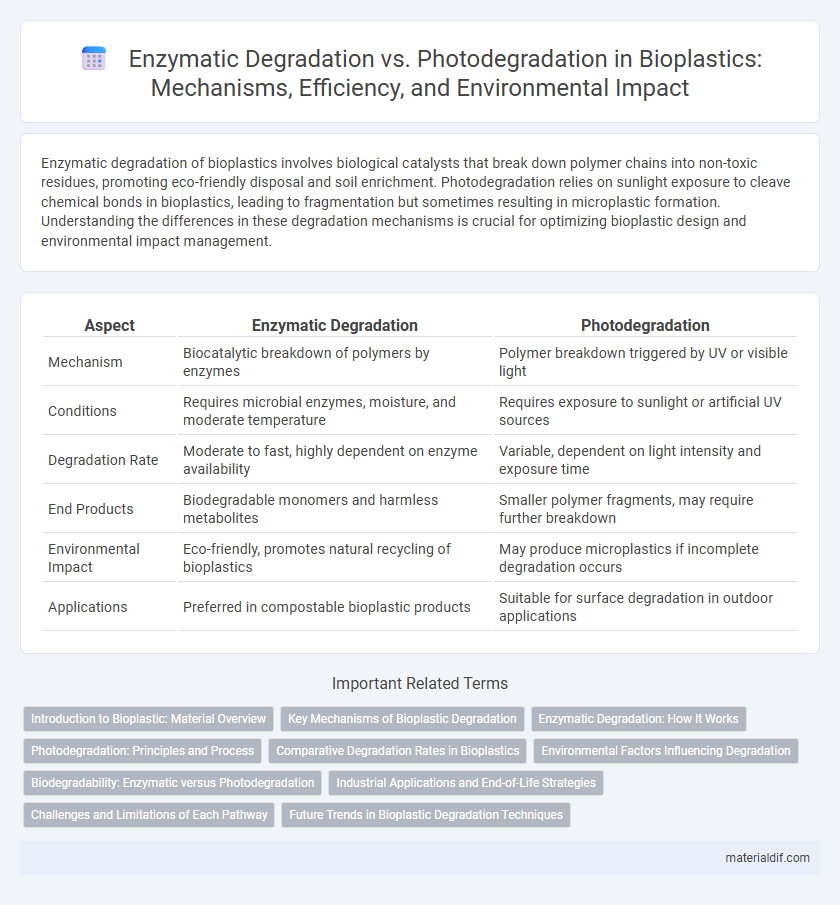Enzymatic degradation of bioplastics involves biological catalysts that break down polymer chains into non-toxic residues, promoting eco-friendly disposal and soil enrichment. Photodegradation relies on sunlight exposure to cleave chemical bonds in bioplastics, leading to fragmentation but sometimes resulting in microplastic formation. Understanding the differences in these degradation mechanisms is crucial for optimizing bioplastic design and environmental impact management.
Table of Comparison
| Aspect | Enzymatic Degradation | Photodegradation |
|---|---|---|
| Mechanism | Biocatalytic breakdown of polymers by enzymes | Polymer breakdown triggered by UV or visible light |
| Conditions | Requires microbial enzymes, moisture, and moderate temperature | Requires exposure to sunlight or artificial UV sources |
| Degradation Rate | Moderate to fast, highly dependent on enzyme availability | Variable, dependent on light intensity and exposure time |
| End Products | Biodegradable monomers and harmless metabolites | Smaller polymer fragments, may require further breakdown |
| Environmental Impact | Eco-friendly, promotes natural recycling of bioplastics | May produce microplastics if incomplete degradation occurs |
| Applications | Preferred in compostable bioplastic products | Suitable for surface degradation in outdoor applications |
Introduction to Bioplastic: Material Overview
Bioplastics are derived from renewable biomass sources such as corn starch, sugarcane, or cellulose and offer a sustainable alternative to conventional plastics. Enzymatic degradation occurs through specific enzymes breaking down biopolymer chains into biodegradable byproducts, facilitating environmental assimilation. Photodegradation involves the breakdown of bioplastics under ultraviolet light exposure, leading to polymer chain scission and gradual material disintegration.
Key Mechanisms of Bioplastic Degradation
Enzymatic degradation of bioplastics involves microbial enzymes breaking down polymer chains into monomers through hydrolysis, effectively accelerating decomposition in composting environments. Photodegradation relies on ultraviolet radiation to induce polymer chain scission by generating free radicals, which weakens the material and enhances subsequent microbial activity. Both mechanisms are critical for determining the environmental fate and biodegradability of bioplastic materials.
Enzymatic Degradation: How It Works
Enzymatic degradation of bioplastics occurs when specific enzymes produced by microorganisms break down polymer chains into smaller molecules, facilitating natural composting processes. This biological mechanism relies on enzymes such as esterases, lipases, and proteases that target the chemical bonds in biopolyesters like polylactic acid (PLA) and polyhydroxyalkanoates (PHA). Enzymatic degradation is favored in controlled composting environments with optimal temperature, moisture, and microbial activity to efficiently convert bioplastics into biomass, carbon dioxide, and water.
Photodegradation: Principles and Process
Photodegradation of bioplastics involves the breakdown of polymer chains through exposure to ultraviolet (UV) radiation, which initiates photochemical reactions causing molecular fragmentation. This process relies on the absorption of UV light by chromophoric groups within the bioplastic, leading to the formation of free radicals that further degrade the material's structure. Photodegradation efficacy depends on factors such as UV intensity, wavelength, oxygen availability, and the presence of photosensitizers embedded in the bioplastic matrix.
Comparative Degradation Rates in Bioplastics
Enzymatic degradation generally occurs at a faster rate in bioplastics due to the action of specific enzymes that break down polymer chains into smaller molecules. Photodegradation relies on UV radiation to induce chemical changes in bioplastic polymers, typically resulting in slower and less complete degradation. Studies indicate enzymatic processes can reduce bioplastic mass significantly within weeks, whereas photodegradation often requires months under natural sunlight conditions.
Environmental Factors Influencing Degradation
Environmental factors such as temperature, moisture, and microbial activity significantly impact the enzymatic degradation of bioplastics, with higher humidity and optimal temperatures accelerating enzymatic hydrolysis by microorganisms. In contrast, photodegradation relies on sunlight exposure, specifically ultraviolet (UV) radiation intensity and duration, which breaks down polymer chains through photo-oxidative reactions. Variations in environmental conditions like light availability and climate determine the relative effectiveness of enzymatic degradation versus photodegradation in bioplastic waste management.
Biodegradability: Enzymatic versus Photodegradation
Enzymatic degradation of bioplastics involves microbial enzymes breaking down polymer chains into natural byproducts, enhancing biodegradability under controlled composting conditions. Photodegradation relies on UV light to initiate polymer chain scission, which may lead to fragmentation but not complete mineralization, often resulting in microplastic residue. Enzymatic degradation offers a more efficient and environmentally benign pathway for bioplastic decomposition compared to photodegradation, which is less predictable and may contribute to persistent pollution.
Industrial Applications and End-of-Life Strategies
Enzymatic degradation of bioplastics leverages specific enzymes to efficiently break down polymers like polylactic acid (PLA) under controlled industrial composting conditions, enabling closed-loop recycling and reducing landfill burden. In contrast, photodegradation relies on sunlight exposure to trigger polymer chain scission, which is less predictable in industrial settings due to variable light intensity and can result in microplastic formation. Industrial applications prioritize enzymatic degradation for end-of-life strategies to ensure complete mineralization and compliance with circular economy principles.
Challenges and Limitations of Each Pathway
Enzymatic degradation of bioplastics often faces challenges due to the variability in enzyme specificity and activity, which can slow down the breakdown process and limit its efficiency across diverse environmental conditions. Photodegradation depends heavily on UV light exposure, causing inconsistent degradation rates in shaded or indoor environments and potentially leading to incomplete polymer breakdown with microplastic residue. Both pathways struggle with scalability in real-world applications, where factors such as temperature, moisture, and presence of suitable microbial communities impact the overall degradation performance.
Future Trends in Bioplastic Degradation Techniques
Future trends in bioplastic degradation emphasize enzymatic degradation due to its specificity, efficiency, and eco-friendliness compared to photodegradation, which relies heavily on UV light exposure and often results in incomplete breakdown. Advances in enzyme engineering and microbial consortia are driving innovations to accelerate bioplastic biodegradation in diverse environments, including marine and soil ecosystems. Integration of these enzymatic methods with smart material design promises enhanced recyclability and reduced environmental persistence of bioplastics.
Enzymatic degradation vs Photodegradation Infographic

 materialdif.com
materialdif.com